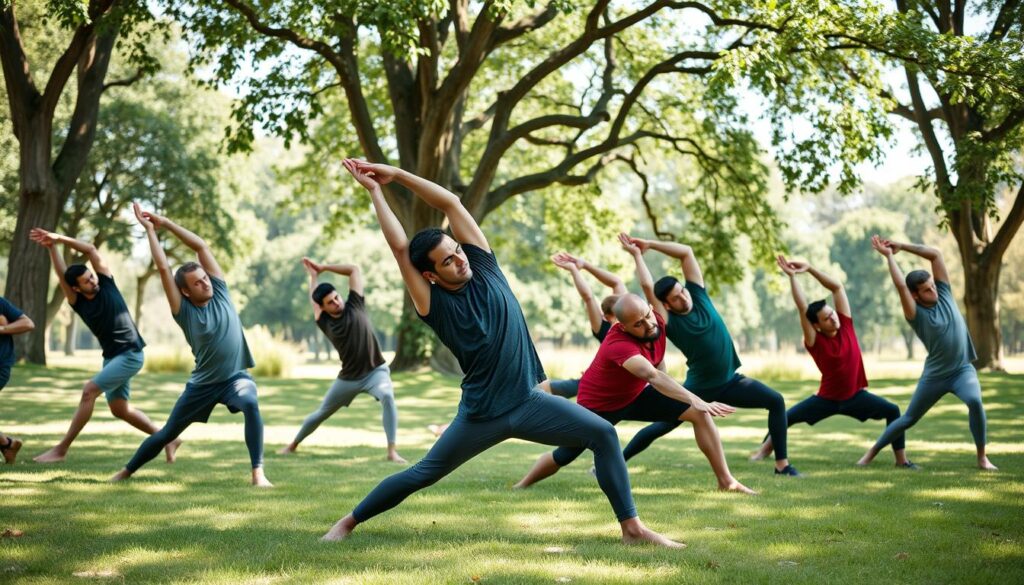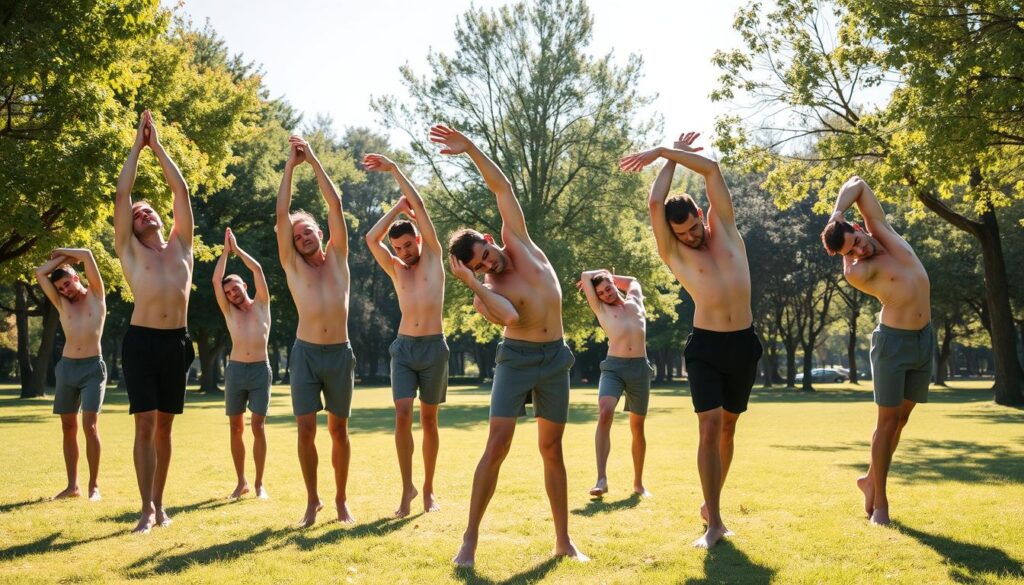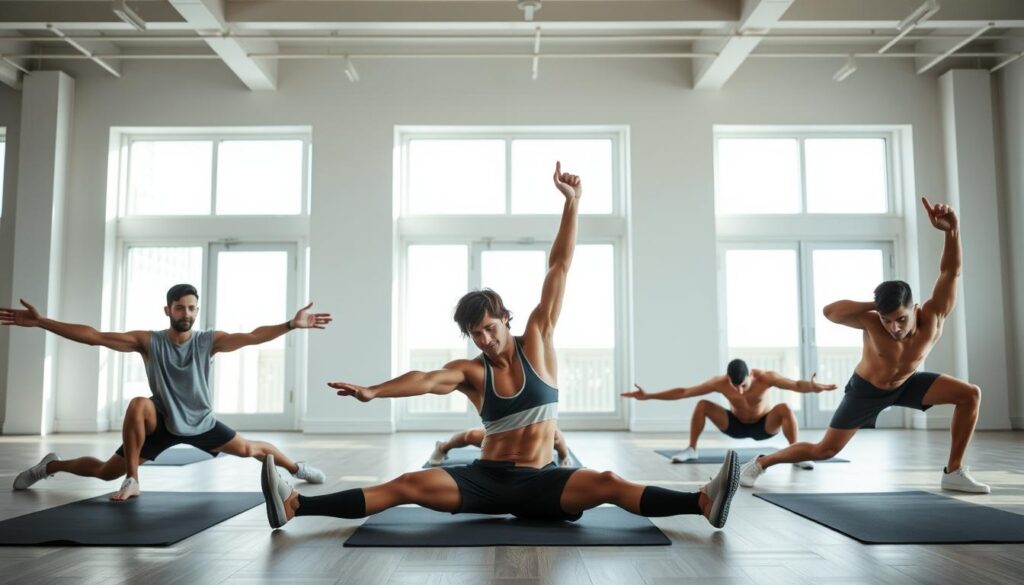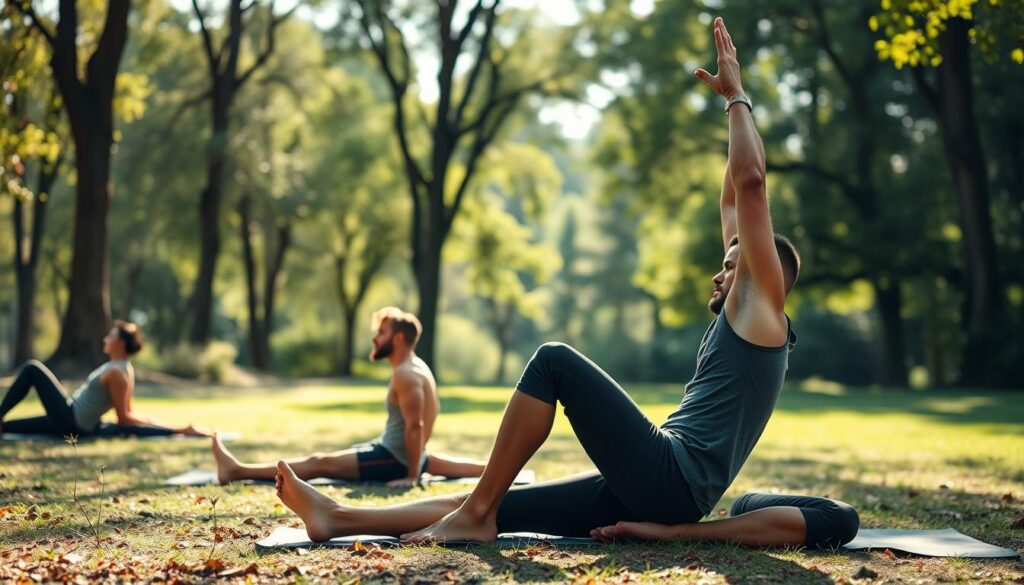Are you ready to unlock your body’s full potential in just 10 minutes a day? A whole body stretch routine can transform your flexibility, posture, and overall well-being. This quick yet effective practice is perfect for those with busy schedules seeking to improve their range of motion and prevent injuries.
Incorporating flexibility exercises into your daily routine can yield remarkable benefits. From enhancing muscle recovery after intense workouts to boosting energy levels through improved blood circulation, a full-body stretching regimen is a game-changer for your physical health.
This 10-minute routine targets major muscle groups, including hamstrings, quads, chest, shoulders, and back. By dedicating just a few minutes each day to these stretches, you’ll notice significant improvements in your flexibility and overall body function.
Key Takeaways
- Regular stretching prevents injuries and improves flexibility
- A 10-minute routine fits easily into busy schedules
- Stretching aids in muscle recovery and growth
- Benefits include better posture and increased range of motion
- The routine targets major muscle groups for full-body flexibility
- Stretching stimulates blood circulation and provides energy boosts
Understanding the Importance of Regular Stretching
Stretching is key for staying healthy and feeling good. It makes you more flexible, lowers injury risk, and boosts blood flow. Let’s look at how stretching can improve your life.
Physical Benefits of Daily Stretching
Stretching for 10 to 15 minutes a day can make a big difference. It lets your joints move better, making you more flexible. Hold each stretch for 30 seconds, or 60 seconds for tough spots.
Doing mobility drills regularly can also improve muscle coordination. This makes moving easier and safer during activities.
Mental Health and Stress Relief Benefits
Stretching is not just for your body; it’s good for your mind too. It involves breathing and being mindful, which lowers anxiety and helps you relax. Stretching calms your nervous system, reducing stress and improving your mood.
Role in Injury Prevention
Stretching is great for avoiding injuries. Doing dynamic stretches before activities warms up your muscles. Static stretches after helps increase flexibility.
Both types of stretching lower the chance of muscle injuries. Stretching also helps your muscles recover faster. This means athletes can get back to their games sooner.
| Stretching Type | Best Time to Perform | Benefits |
|---|---|---|
| Dynamic Stretching | Before physical activities | Warms up muscles, improves range of motion |
| Static Stretching | After exercise | Increases flexibility, aids in cooldown |
| PNF Stretching | During flexibility-focused sessions | Most effective for increasing flexibility and range of motion |
Consistency is important. Stretching at least three times a week keeps you flexible and injury-free. This is especially true if you’re active often.
Preparing Your Body for the Whole Body Stretch Routine
Get ready to boost your flexibility and enjoy a great post-workout cooldown. Setting up the right environment and using proper techniques are key to a successful stretching session. Let’s explore how to prepare your body for an effective whole body stretch routine.
Creating the Right Environment
Choose a quiet, comfortable space for your stretching routine. Make sure you have enough room to move freely. A yoga mat can provide cushioning and grip.
Dim lighting and calming music can help you relax and focus on your stretches.
Proper Breathing Techniques
Breathing is crucial for effective stretching. Take deep breaths to oxygenate your muscles and promote relaxation. Inhale deeply before each stretch and exhale slowly as you move into the stretch.
This technique can enhance your range of motion improvement and help you sink deeper into each pose.
Safety Guidelines and Precautions
Safety should be your top priority during stretching. Avoid bouncing or jerking movements, which can lead to injury. Instead, ease into each stretch gently.
Hold static stretches for 20-30 seconds, repeating 2-4 times. For dynamic stretches, perform controlled movements 10-15 times.
- Always warm up for 5-10 minutes before intense stretching
- Stretch to the point of tension, not pain
- Consult a healthcare professional if you have any existing injuries or conditions
Remember, consistency is key. Aim to stretch major muscle groups 2-3 times a week. With proper preparation and technique, you’ll maximize the benefits of your stretching routine and improve your overall flexibility.
Types of Stretching Methods for Maximum Results
Stretching is key for flexibility exercises and mobility drills. Let’s explore different methods to enhance your active lifestyle stretches.
Static vs Dynamic Stretching
Static stretching involves holding a position for 30 seconds to 2 minutes. It’s great for post-workout routines. Dynamic stretching uses controlled movements, typically 8-12 repetitions. It’s perfect for warm-ups.

Active vs Passive Stretching
Active stretching uses your own muscle strength and is held for 10-15 seconds. Passive stretching relies on external forces. Both are effective for improving flexibility.
When to Use Each Type
Choose your stretching method based on your activity:
- Dynamic stretches before workouts
- Static stretches after exercise
- Mix types for overall flexibility improvement
| Stretch Type | Duration | Best Use |
|---|---|---|
| Static | 30 sec – 2 min | Post-workout |
| Dynamic | 8-12 reps | Pre-workout |
| Active | 10-15 sec | Anytime |
| PNF | 6-10 sec contract, 30 sec hold | Flexibility focus |
Remember, regular stretching improves flexibility, prevents injuries, and aids recovery. Incorporate these methods into your routine for a more flexible, mobile lifestyle.
Whole Body Stretch Routine Components
A good full-body stretching routine covers all major muscle groups. It helps with muscle recovery and improves range of motion. Make sure to stretch your neck, shoulders, chest, back, arms, core, hips, glutes, quads, hamstrings, and calves.
Use both static and dynamic stretches for the best results. Dynamic stretches are great for warming up. Static stretches are better for cooling down. A 2018 study showed that dynamic stretches before exercise can improve athletic performance.
Try to do 8-10 different stretches in your routine. Hold static stretches for 20-30 seconds. Or repeat dynamic movements 10-15 times. This way, you can finish the routine in about 10 minutes, perfect for daily use.
- Calf stretch
- Leg swings
- Hamstring stretch
- Quadriceps stretch
- Glute stretch
- Upper back stretch
- Chest stretch
- Neck circles
Stretching is not just for athletes. A 2015 study with 16 men showed that static stretching improved blood vessel function. Another study found that stretching and strengthening reduced pain from poor posture in 88 university students.
Make stretching a part of your daily routine. It will improve your flexibility, reduce muscle tension, and boost your overall health. Your body will appreciate the regular stretching and muscle recovery.
Upper Body Stretching Sequence
A good upper body stretching routine is essential for staying flexible and recovering muscles. It targets key muscle groups to boost mobility and ease stress.

Shoulder and Neck Stretches
Begin with neck rolls, doing them 3 times. Then, do shoulder rolls twice. These actions help loosen up your upper body.
Chest and Back Extensions
Do doorway stretches or lying chest openers to widen your chest. For your back, try cat-cow poses and seated spinal twists. Hold each stretch for 30 seconds to 1 minute.
Arm and Wrist Mobility
Boost arm flexibility with tricep stretches. Hold your arm behind your head for 10 seconds, repeating 3 times. For wrists, do circles and finger stretches to improve mobility.
| Stretch | Duration | Repetitions |
|---|---|---|
| Neck Rolls | – | 3 times |
| Shoulder Rolls | – | 2 times |
| Tricep Stretch | 10 seconds | 3 times |
| Chest/Back Stretches | 30-60 seconds | As needed |
Always breathe deeply and keep the right form while stretching. This routine, done daily for 10-15 minutes, greatly boosts upper body flexibility and lessens muscle tension.
“Incorporating a daily stretching routine offers various benefits for physical and mental well-being.” – Logan Aldridge
Lower Body Flexibility Exercises
Adding flexibility exercises to your whole body stretch routine is key. It boosts range of motion and health. Lower body stretches work on big muscles, making you more flexible and less injury-prone.
Hip and Glute Stretches
Begin with pigeon pose and figure-four stretches for your hips and glutes. These moves loosen tight muscles and boost lower body mobility. Hold each stretch for 30 seconds for the best results.
Hamstring and Quad Movements
Work on hamstring and quad stretches for leg flexibility. Try standing forward bends and seated hamstring stretches. For quads, do lunges or standing quad stretches. These can ease low back pain and improve your posture.

Calf and Ankle Mobility
Boost calf flexibility with wall or step stretches. Use ankle rotations and calf raises to improve ankle mobility. These moves help with balance and lower leg injury prevention.
| Stretch Type | Duration | Frequency | Benefits |
|---|---|---|---|
| Hip and Glute | 30 seconds | 2-3 times/week | Improved mobility, reduced tightness |
| Hamstring and Quad | 30-60 seconds | Daily | Reduced back pain, better posture |
| Calf and Ankle | 30 seconds | 2-3 times/week | Enhanced balance, injury prevention |
Regularly doing these lower body stretches can show big improvements in two weeks. Always warm up before stretching and pay attention to your body to avoid too much strain.
Core and Spine Mobility Work
Focusing on core and spine mobility is key for full-body stretching. Your thoracic spine is very important for your health. Let’s check out some stretches for this area.

Did you know poor thoracic mobility can cause stiffness and neck pain? It can even make breathing hard. For those who love fitness, good thoracic mobility is essential for safe lifting.
| Issue | Impact |
|---|---|
| Limited thoracic mobility | Reduced respiratory function |
| Poor alignment | Pelvic floor dysfunction |
| Sedentary lifestyle | Increased risk of thoracic immobility |
To boost your core and spine mobility, try Cat-Cow stretch, Thread the Needle, and Downward Dog. Do 15 minutes of back exercises every day. This will strengthen muscles and ease pain.
A stable pelvis is crucial for good thoracic mobility. Start with five reps of each exercise and work up to 30. Do this routine in the morning and evening for best results.
Post-Stretch Recovery and Maintenance
After stretching, it’s important to focus on recovery. This helps you get the most from your stretching. It also supports your active lifestyle. Let’s look at some key recovery tips.
Proper Cool Down Techniques
Cooling down is key for muscle recovery. Slow your heart rate with gentle moves and deep breaths. This breaks down lactic acid and lowers muscle soreness.
Try walking in place or doing light arm circles for 5-10 minutes.
Hydration Guidelines
Staying hydrated is crucial for muscle recovery. Drink water before, during, and after stretching. Aim for at least 8 ounces of water after stretching to help your body recover.
Recovery Tips
Here are some tips to help you recover:
- Use a foam roller to release muscle tension
- Apply ice to sore areas for 15-20 minutes
- Consider a warm bath to relax muscles
- Get enough sleep to repair and recover
Consistency is key. Make stretching a part of your daily routine. Even 10 minutes of stretching can improve flexibility and reduce muscle tension.
“Stretching is crucial to prevent injury, pain, and strains during physical activity.”
By following these recovery tips, you’ll help your body heal. You’ll also keep your flexibility from stretching.
Conclusion
Adding a 10-minute whole body stretch routine to your day can change your flexibility and health. Even though studies on stretching are mixed, many experts think it’s good for active people. The routine we shared targets big muscle groups, which might help you move better and avoid injuries.
There are many ways to stretch. You can do static stretches, holding a pose for 30 seconds, or dynamic stretches that move your body. Active and isolated stretches, which use gentle movements, are also good for your active lifestyle.
Research on stretching’s effects is not always clear. But many fitness groups still say stretching every day is a good idea. As you stretch, pay attention to how your body feels and make changes if needed. Staying consistent with these stretches can make you more flexible and comfortable.
